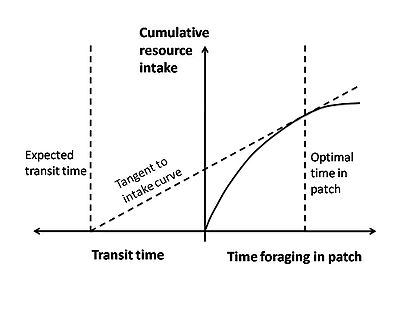
Marginal value theorem
Encyclopedia

Behavioral ecology
Behavioral ecology, or ethoecology, is the study of the ecological and evolutionary basis for animal behavior, and the roles of behavior in enabling an animal to adapt to its environment...
, the marginal value theorem (MVT) considers an optimally foraging
Optimal foraging theory
Optimal foraging theory is an idea in ecology based on the study of foraging behaviour and states that organisms forage in such a way as to maximize their net energy intake per unit time. In other words, they behave in such a way as to find, capture and consume food containing the most calories...
animal exploiting resources distributed in patches and that must decide when to leave a patch to start searching for a fresh one. The animal is assumed to have evolved
Evolution
Evolution is any change across successive generations in the heritable characteristics of biological populations. Evolutionary processes give rise to diversity at every level of biological organisation, including species, individual organisms and molecules such as DNA and proteins.Life on Earth...
to optimize a cost/benefit ratio: searching for and manipulating food is costly, while consuming food is a benefit. The decision taken by animals appears to be based on an expected transit time among patches and an observed intake rate within each patch. Examples include bee
Bee
Bees are flying insects closely related to wasps and ants, and are known for their role in pollination and for producing honey and beeswax. Bees are a monophyletic lineage within the superfamily Apoidea, presently classified by the unranked taxon name Anthophila...
s visiting flower
Flower
A flower, sometimes known as a bloom or blossom, is the reproductive structure found in flowering plants . The biological function of a flower is to effect reproduction, usually by providing a mechanism for the union of sperm with eggs...
s, bird
Bird
Birds are feathered, winged, bipedal, endothermic , egg-laying, vertebrate animals. Around 10,000 living species and 188 families makes them the most speciose class of tetrapod vertebrates. They inhabit ecosystems across the globe, from the Arctic to the Antarctic. Extant birds range in size from...
s eating berries, or even mobile phone
Mobile phone
A mobile phone is a device which can make and receive telephone calls over a radio link whilst moving around a wide geographic area. It does so by connecting to a cellular network provided by a mobile network operator...
shop owners (in which case the "resource" being exploited is paying customers).
The theorem predicts that individuals will stay longer:
- as the distance between patches increases,
- when the environment as a whole is less profitable.
The theorem states that the optimal time spent in a patch is given by the tangent to the resource intake curve that departs from the expected transit time value.
Plants have also been shown to obey the predictions of the MVT. Plant roots traveling through soil will slow their growth rate in order to remain in patches of higher soil resources for longer periods of time in exactly the same way as animals.
The MVT has been criticised on the grounds that few foragers are optimal (typical limiting factors include inability to assess exploitation rate and lack of knowledge of distant patch existence). Nevertheless, it predicts behavior that is compatible with many types of real forager behavior.
Example
A common illustration is elicited with appleApple
The apple is the pomaceous fruit of the apple tree, species Malus domestica in the rose family . It is one of the most widely cultivated tree fruits, and the most widely known of the many members of genus Malus that are used by humans. Apple grow on small, deciduous trees that blossom in the spring...
picking in human
Human
Humans are the only living species in the Homo genus...
s. When one first arrives at a new apple tree, the number of apples picked per minute is high but it rapidly decreases. Strategies where too few apples are picked from each tree or where each tree is exhausted are sub-optimal because they result, respectively, in time lost travelling among trees or picking the hard to find last few apples from a tree. The optimal time spent picking apples in each tree is thus a compromise between those two strategies, which is quantitatively described by the MVT.

